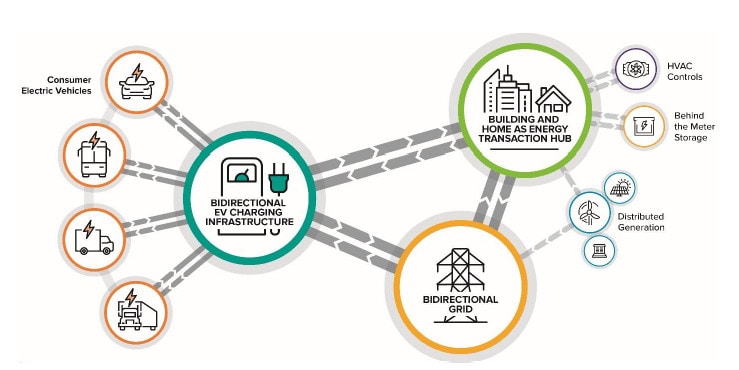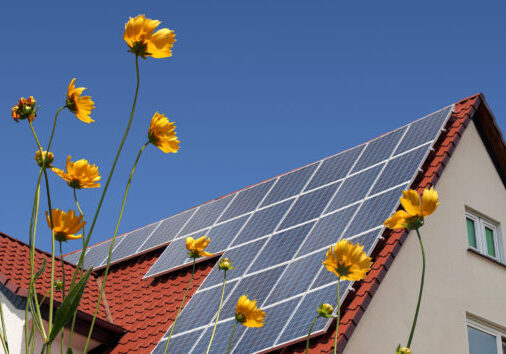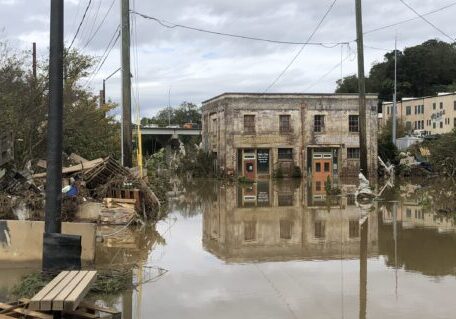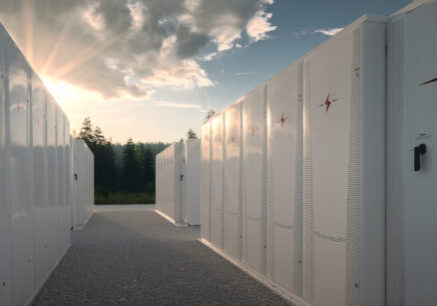March 21, 2023
Electric Vehicles and the Case for Resilience
By Michael Brower
This blog is the third in a series exploring the topic of electric vehicles and equity. Read parts 1 and 2 here and here.
Resilience is something you usually don’t know you need – until you do.
When Hurricane Sandy hit the Northeast in late October 2012, floods and high winds caused huge damage to homes, businesses, and infrastructure, including the power grid. Two weeks after the storm passed, 5% of New York residents were still without power.1 Other major storms, such as hurricanes Katrina, Rita, Wilma, and Ike, also led to weeks-long outages.2 It took more than a year for some households in Puerto Rico to have power restored after Hurricane Maria decimated that island’s grid in 2017.
The effects of such long outages on everyday life make a long list – particularly for lower income individuals and households who can’t afford to be off work or to move temporarily to other areas. Without power, food rots quickly, essential medicines degrade, heat and air conditioning fail, businesses and jobs close, and communications become difficult. The impacts on human health can be severe. In Texas, the extended blackouts that followed the winter storms of February 2021 claimed 246 lives. Winter blackouts could be repeated in coming years in that state, leaving residents who rely on electric heat again at grave risk.3
Severe heat waves and cold spells can also cause transient problems by boosting power demand beyond what the grid can supply and by making the grid more vulnerable to individual failures of generators and transmission lines. Parts of the West, Midwest, and South are at growing risk of rolling blackouts and brownouts (drops in voltage and frequency) caused by huge demand for air conditioning during heat waves as well as a drop in available hydropower during extended droughts.4 While not as dangerous as extended blackouts, such transient events can have a significant impact on daily life and can cause health problems as vulnerable residents are forced to cut back their use of air conditioning or heat.
How Bidirectional Charging Can Enhance Resilience
EVs can help mitigate the risks of severe weather events. Equipped with appropriate bidirectional (two-way) charging equipment, they can provide a backup source of power to keep disaster shelters, community centers, medical offices, emergency services, and other services in operation. Being mobile, EVs can drive to areas where there is no outage or there is a source of resilient local generation, such as an EV charging station powered by solar, to be recharged, and then return to the community and resume delivering power. They need no special shipments of generators or fuel. Their very mobility is one of their biggest advantages. They can even be deployed to neighborhoods to serve as mobile charging hubs for cell phones and medical devices. Widespread use of EVs could also help avoid blackouts and brownouts by shifting power supply from low-demand to high-demand periods. This is why many electric utilities are actively supporting early-stage vehicle-to-grid programs.
While the technology of bidirectional (two-way) charging is not yet widely adopted, EVs with the capability of sending power to the grid are already on the road (Table 1). Nissan was one of the first car companies to equip its EV, the Leaf, with bidirectional chargers, and others are following suit. Ford has made the F-150 Lightning’s ability to keep the lights on when the grid goes dark a key message of the truck’s marketing campaign: “What if the next time your power went out, your pickup truck could electrify your home.”5
Bluebird, a leading electric school bus manufacturer in the US, likewise offers two-way charging in its electric buses. This bus – like the F-150 – contains a relatively large battery pack (roughly twice the size of that on most electric cars) which can provide power for up to several days depending on the size of the load. Other electric bus manufacturers offer the same capability.

There are three main ways EVs can be used to feed power to other systems and networks: Vehicle-to-Grid (V2G), in which the vehicle connects directly to the power grid, just like a small power plant; Vehicle-to-Home (V2H) or Vehicle-to-Building (V2B), in which the vehicle connects to the power distribution within a home or business, behind the utility meter; and Vehicle-to-Load (V2L), in which the vehicle connects directly to a set of devices such as lighting and appliances. The simplest of these is V2L: it suffices to plug the appliance directly into the charger that’s connected to the vehicle. V2H/B and V2G require additional equipment and software to manage the power flows and interactions with the grid.
Numerous demonstration projects have been or are being performed to show that bidirectional technology in its various forms works. For instance, Electric Frog Company is providing free use of a Nissan Leaf to the Burrillville Wastewater Treatment Facility in Rhode Island. When not in use by Burrillville employees, the EV will be plugged into a bidirectional charger, with the ability to feed power back to the grid to help meet peak loads. 6 Among other programs, the California Energy Commission recently approved three “vehicle-to-grid integration (VGI)” pilots focused on residential, commercial, and microgrid applications in the PG&E utility area;7 the charging company EV Connect is partnering with Indiana’s Battery Innovation Center and Energy Systems Network to demonstrate bidirectional technology for school buses and heavy-duty truck fleets;8 and even the Department of Defense is getting in on the act with an initiative to test between 100 and 500 EVs in bidirectional applications at military bases.9
How to Implement Bidirectional EV Charging
Making use of bidirectional EVs to offset peak loads or keep the lights on in a blackout requires not only an appropriately equipped vehicle, but a charging point that can receive power from it and deliver the power to where it is needed. Even if your home or business is equipped with a standard charging station, you cannot use it to run your lights and appliances when the grid is out. It just won’t work.
One reason is that batteries use direct current (DC), rather than the alternating current (AC) used in homes and businesses. This means they cannot directly power most services such as refrigerators, lights, and televisions. Batteries need an inverter to convert between DC and AC, which can be either on the vehicle or in the charging station. For bidirectional charging, the inverter must be able to operate in both directions. These components are often part of what are called “smart” charging systems because they use computers and sensors to decide when and how much power to deliver in either direction.

There are several different bidirectional charging systems on the market, with more in development. Unfortunately, they are not all compatible with one another. Tesla and Ford maintain their own charging networks with their own standards. This can result in confusion, so it is best to consult the vehicle manufacturer to make sure a particular vehicle’s charging system works safely with the receiving station.
Over time, as the technology matures, the industry should coalesce around a standard that makes most bidirectional EVs and EV chargers mutually compatible.
What Services Can Bidirectional EVs Support – and How Long?
With the right charging equipment, an EV can provide 110-volt or 220-volt AC power that can support most services – such as lighting, A/C, refrigeration, and computers – for as long as its battery lasts. But how long is that? That depends mainly on three things: the size of the battery, the size of the load (the total amount of power required), and whether there is additional on-site power, such as from a solar array, to satisfy part of the load and replenish the EV battery.
Let’s start with a single-family household. Energy use for any specific household can vary a lot depending on its size, type of construction, location, climate, heating and cooling systems, and other factors. The average American home consumes about 11,000 kWh per year, at an average power draw of 1.25 kW.10 A typical electric car battery stores up to about 50-75 kWh, implying that it could supply such a home at its regular usage rate for about 2 days. A larger vehicle like the F-150 Lightning, on the other hand, with its 134-kWh battery, could power the same home for around 4.5 days. That’s without any solar on the house.
In an emergency, power demand could be reduced, thereby extending the time it takes to discharge the battery. If the same household used full power only for water heating, lighting, and refrigeration, cut power use in half for air conditioning and heat, and shut off all other uses, a typical electric car could power the home for around 3.5 days, and a vehicle like the F-150 for just over a week. This is enough to get through most blackouts.
On a larger scale, fleets of electric cars, vans, and buses could power many essential community services almost indefinitely, thanks to their mobility. To take an example: A police station in Washington, DC, consumes an average of about 125 kW to keep its services running around the clock.11 A single electric passenger bus with 200-300 kWh storage could power full operations of one such station for around two hours. A fleet of, say, four buses taking turns and driving to be recharged in another city or at an emergency generator station could keep it in operation almost indefinitely (depending on distance to the recharging point).
Most community emergency shelters, such as school gymnasiums and churches, require less power than a police station, and so could be powered longer by a single vehicle. Actual power usage varies widely, of course, depending on the building size, local climate, and types of services delivered. Any community considering using bidirectional charging should carefully study the requirements to incorporate it into their emergency planning. Organizations like the Federal Emergency Management Agency (FEMA) can provide useful guidance.12
Pilot Projects
As we saw in the last blog, electric school buses are the “point of the spear” in expanding the use of community EVs. Initiatives like that of the Stockton Union School District (SUSD) in Stockton, California, envision eventually using their school buses and other municipal electric vehicles to support the power grid and earn revenue during peak load periods and to provide backup power during outages caused by events such as wildfires. However, it will require further work and investment to provide essential infrastructure, such as schools and emergency services, with the equipment to receive power from the buses.
One of the main lessons learned from these initiatives is the importance of optimizing charging strategies to minimize the number and capacity (in kW) of chargers required, avoid overtaxing the power grid, and take advantage of off-peak electricity rates. The Mobility House, a private consulting firm based in Germany, advised the SUSD on its charging strategy, and claims to have reduced the peak capacity requirement for the current fleet of 11 electric buses from 317 kW to 79 kW and the annual charging cost by $25,700 per year, compared to an unmanaged strategy.
Several pilot projects demonstrate the potential to use electric school buses to feed power into the grid in the Northeast. In one located in Beverly, Massachusetts, a Thomas Built Buses electric school bus helped the local utility, National Grid, meet peak loads over the course of 30 events in the summer of 2021.13 In another, located in White Plains, New York, five electric school buses built by Lion Electric Company of Quebec have demonstrated the ability to feed power to the ConEdison grid in a pilot program that started in 2018.14
In both cases, the goal is to demonstrate how electric buses can help utilities meet peak loads and so reduce the need for costly peaking power. In fact, the main instigator of such initiatives has not been school districts or town governments, it has been the utility companies who face high costs and a growing risk of outages due to rising peak loads. Nonetheless, the towns stand to receive an economic benefit, as well, as they can be reimbursed for the power provided to the grid at a much higher rate than they pay for charging the buses at night and, in some cases, generate revenue through participation in utility demand response programs that are beginning to explore EV participation.
By supplying power during periods of peak demand, EVs such as buses can be an important part of an overall strategy to replace peaking power plants with clean energy solutions, which has important environmental justice benefits. According to analysis by Clean Energy Group, a disproportionate number of peaking power plants are in lower income communities and communities of color. These plants also tend to emit harmful pollutants at higher rates, severely impacting the health of surrounding communities. Clean Energy Group’s Phase Out Peakers initiative seeks to call attention to the pollution and cost impacts of fossil peaking units and accelerate the transition to clean alternatives, including EVs providing demand response.15
At the same time, the pilot programs provide confidence that bidirectional charging would work in the event of a grid outage. However, that application requires additional investments in “smart grid” equipment, which after sensing a grid failure can isolate the buildings or services from the grid and deliver electricity from the buses to power essential services.16
Other organizations are seeking to incorporate EVs into complete resilient power solutions for their communities. The Glad Tidings International church, for example, is planning to build a “clean energy hub” that includes 668 kW of solar, ten Level 2 and four Level 3 (fast) bidirectional charging points, and a combination of stationary batteries and EVs able to supply power for the Glad Tidings campus for 3 days without sun, and indefinitely with sun. Bidirectional EVs (2 Nissan Leafs and a Kia EV6) are a critical part of their plan and provide the bulk of the storage capacity.
NEXT IN THIS SERIES: Electric Vehicles in the Community: Challenges and Solutions
Michael Brower is the former President of AWS Truepower, LLC, a global renewable energy consulting firm, and the former Vice President for Renewable Energy at Underwriters Laboratories. A physicist by training, Michael is currently a partner at Clean Energy Ventures Group.
Footnotes:
(1) https://www.pennlive.com/midstate/2012/11/restoring_power_to_hurricane_s.html
(2) https://www.sfgate.com/nation/article/Length-of-outage-after-Sandy-not-unusual-4045567.php
(3) https://www.nerc.com/news/Headlines%20DL/WRA_final%2018NOV21.pdf
(4) https://www.nerc.com/pa/RAPA/ra/Reliability%20Assessments%20DL/NERC_SRA_2022.pdf
(5) https://www.youtube.com/watch?v=oc3sQ2UcTlg
(6) https://www.power-grid.com/der-grid-edge/v2g-pilot-project-with-national-grid-to-help-combat-summer-peak-loads-in-new-england/#gref
(7) https://www.utilitydive.com/news/california-approves-117m-vehicle-to-grid-pilots-in-pge-footprint/621393/
(8) https://cleantechnica.com/2021/03/17/ev-connect-pilots-large-us-v2g-project/
(9) http://electricvehicle.ieee.org/files/2013/03/DoD-Plug-In-Electric-Vehicle-Program.pdf
(10) https://www.eia.gov/energyexplained/use-of-energy/electricity-use-in-homes.php
(11) https://doee.dc.gov/sites/default/files/dc/sites/ddoe/publication/attachments/Pdf9-Police_Stations_Benchmark_Page.pdf. Metropolitan police stations use relatively large amounts of power for their round-the-clock operations.
(12) https://www.wbdg.org/FFC/DHS/femap1019.pdf
(13) https://www.greencarcongress.com/2021/10/20211014-proterrav2g.html
(14) https://electrek.co/2019/08/23/electric-v2g-school-bus-pilots-grow/, https://electrek.co/2020/12/14/new-york-vehicle-to-grid-school-bus-pilot-program-success/
(15) https://www.cleanegroup.org/initiatives/phase-out-peakers/














